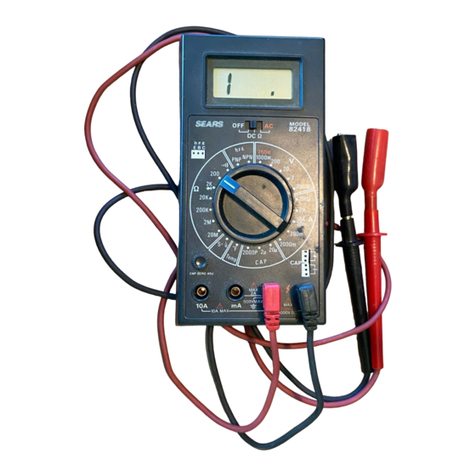
DESCRIPTION
Ideal for use where measurements must not appreciably disturb
the circuit being tested, the Model Sears 5205 features high
50,000 ohms/volt DC and 10,000 ohms/volt AC sensitivities, on
one set of voltage ranges. A second group of voltage ranges with
- sensitivities of 25,000 ohms/volt DC and 5,000 ohms/volt AC
has been designed into this instrument. Because of the avail-
ability of 12 DC voltage ranges and
8
AC voltage ranges, more
accurate readings are possible with this instrument than with
an ordinary VOM. Also included are ten DC current ranges and
five resistance ranges to assure precise current and resistance
indications. In conjunction with a power supply, the Model
Sears 5205 can be used to measu re capacitance and inductance.
Special circuitry has been included to protect the meter move-
ment against accidental overload. A mi rror arc has been pro-
vided to help eliminate parallax errors from readings. A con-
venient carrying handle built onto the case can also be used to
Position the meter for easy reading. The Sears 5205 is a quality
product in both performance and appearance.
SPECI FICATIONS
DC Voltage: ()'0.25, 2.5, 10, 50, 250, 1000 volts : 3 % of
full scale reading except 0.25, 2.5, 1000
volts ±4%; 25,000 ohms/volt.
()'0.125, 1.25, 5, 25, 125, 500 volts : 3 % of
full scale reading except 0.125, 1.25, 500
volts ±4%; 50,000 ohms/volt:
AC Voltage: 0-10, 50, 250, 1000 volts ±4% of full scale
reading; 5,000 ohms/volt.
0- 5, 25, 125, 500 volts ±4% of full scale
reading; 10,000 ohms/volt.
2
Decibels:
DC Current
-20 to +62 dB, 8 ranges.
0-25, 50 }J.A: 0-25, 5, 25, 50, 250,
500 mA;
±3
% of full scale read ing.
Ohmmeter: 0-20 Megohms in 5 ranges ±3% of full
scale arc.
1.5V AA, AAA Cell 125 mA Load Current.
1.5V C, D Cell 250 mA Load Current
9V Cell 10 mA Load Cu rrent.
One 9-volt battery (Sears Diehard AI kaline
No. 34-3094; Sears Heavy Duty No. 34-
4662) for R x 10K range; one 1.5-volt
"AA" cell (Sears Diehard AI kaline No.
34-3090) for all other ohmmeter ranges.
6-3/4" x 5" x
Z'
1 lb., 4
oz.
Battery Test:
Power Supply:
Size:
Weight:
HOW TO INSTALL BATTERIES
Remove the screws in the rear cover of the case- Lift the back of
the case off the front section. Note the orientation of the bat-
teries in their compartments. When replacing the" AA"cell, the
positive
(+)
end of the cell should be at the end so indicated on
the case closest to the top. Be sure that the contact at each end
of the compartment makes a good connection with the metallic
battery terminal at its positive end and with the metallic
portion of the battery case at its negative end.
The 9 volt battery must be so oriented that its plus terminal is at
the connector marked
"+"
in the case (closest to the side) and
its minus terminal is at the connector marked "-". Slide the
battery straight down into its compartment, being sure that it is
held firmly.
3


























